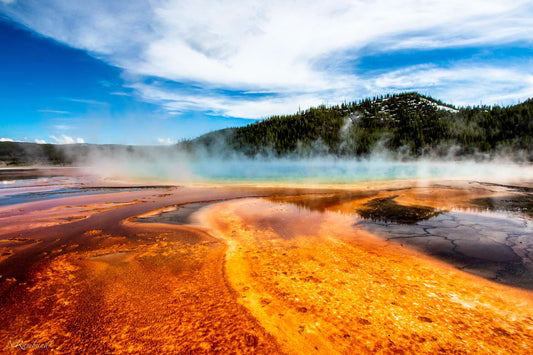Yellowstone National Park (which is so huge it crosses into multiple states!) is often discussed together with Glacier National Park and Grand Teton National Park, due to their geographic proximity. You might wish to spend some time in all three while you visit the area. Each offers opportunities for eBike riders, subject to a few rules and regulations you should be aware of.
Yellowstone, Glacier, and Grand Teton National Parks offer immense scenic beauty. At the same time, vehicle traffic can be heavy on the narrow, winding roads, which don't have bike lanes or wide shoulders - so you should carefully consider when and where it makes sense to ride in the parks. Only experienced cyclists should consider the open roads. The good news is there are many opportunities to ride in these parks with much less, or no, motor vehicle traffic.
Before visiting, make sure you also thoroughly understand where you can, and can't ride, and where you should ride, based on your abilities and comfort level. You may wish to bring your eBike, but also plan for some sightseeing by car or on foot to maximize your Yellowstone visit. If you're considering a trip, here's what to know before you go.
eBike rules in Yellowstone, Glacier, and Grand Teton National Parks
Low-speed electric bikes (Class I and II models, which top out at 20 MPH) are permitted anywhere in these parks where traditional bicycles are allowed. That includes public roads, parking areas, and designated routes. You must follow the same traffic rules as automobiles, including obeying the speed limit, which can be low on park roads.
These National Parks bar the use of throttle eBikes EXCEPT on roads open to motor vehicles. Outside those locations, you'll need to use pedal assist and pedal the bike yourself, relying on throttle and not pedaling isn't permitted.
Bikes are prohibited on backcountry trails and boardwalks. Got a "fat bike" with huge wide tires for snow riding? Riding on oversnow routes isn't allowed, unfortunately. You might find opportunities for snow riding just outside the National Park boundaries if you're interested in this type of eBiking.
Park "trails" are generally closed to bicycles in Yellowstone, Glacier, and Grand Teton National Parks
Most park trails (think a dirt hiking trail) are only open to pedestrians. Bicycles of any type are prohibited on all backcountry trails.
If you have an off-road capable eBike, check out some of the gravel roads that are open to both bicycle and car traffic as a possible alternative. The excellent maps provided by the park service in PDF format have a high level of detail for route finding.
Recommended places to ride in Yellowstone
Check out these recommended ride spots where bikes and eBikes ARE allowed. Yellowstone calls them "mountain biking" but most are dirt and gravel roads. Most eBikes with wider tires can handle them:
- the Old Gardiner Road allows two-way traffic for bikes, but only one-way auto traffic, adding an additional measure of safety for bicycle riders.
- Riverside Bike Trail, just inside the West entrance
- Fountain Freight Trail - six miles North of Old Faithful
- Lone Star Geyser Bike Trail
Recommended places to ride in Glacier National Park
As in Yellowstone, you can ride on any paved or unpaved road Glacier National Park (subject to the warnings about narrow, winding roads and car/truck traffic), plus these ideal designated multi-use trails which are ideal for bikes:
- The Fish Creek Bike Path from Grist Road to Fish Creek
- The paved bike path from Glacier National Park Headquarters to Apgar Village, Visitor Center, and Campground
- The old Flathead Ranger Station trail accessed from Quarter Circle Bridge Road
- The section of Inside North Fork Road, which is currently restricted to vehicles, between Camas Creek and Logging Creek
Recommended places to ride in Grand Teton National Park
You may ride your eBike on all paved roads in Grand Teton National Park, plus two gravel roads:
- Two Ocean Lake Road
- Grassy Lake Road
Additionally, the Grand Teton area around the town of Jackson has a substantial network of paths called the Multi-use Parkway. Note: this Parkway has yet another unique set of rules: battery assist eBikes are permitted here, but only by the physically disabled, so plan accordingly. Riding your eBike with the battery removed would likely be considered compliant. Be nice.
Bicycle Rentals
If you aren't ready to commit to bringing your own bike, rentals are available at the National Park Lodge at Old Faithful in Yellowstone. This is a great option for exploring the general area and getting a quick bit of exercise.
Paved roads that are closed to cars, but open to bikes
As with Yosemite, bike riders sometimes have opportunities to ride on paved roads that are temporarily closed to cars*, for an amazing car-free experience. In Yellowstone, there is a small window in Springtime when 49 miles of roads from the West entrance to Mammoth Hot Springs have been plowed, but are still closed to motorized vehicles. If you're willing to face potentially cold and unpredictable Spring weather (check the forecast before you go!) this can be an amazing ride. Bicycles are also permitted from the East Entrance to the East end of Sylvan Pass, and from the South Entrance to West Thumb, both as conditions allow in Yellowstone.
These programs are so popular that Yellowstone has a special Spring and Fall bicycling page to track the current status of the roads. Well worth reading before you go.
Similarly, in Glacier National Park riders have the opportunity to ride the Going to the Sun road, again, while cars are restricted during plowing. As in Yellowstone, check before you go, because the plowing date varies by season and conditions can change rapidly.
* During these times, the roads are closed to public motor vehicles, but you could still encounter park employees, contractors, and snow plows occasionally. Be aware.
Be prepared for changing weather
Be aware of rapidly changing weather conditions in these parks, and the distance between developed areas. Heavy snow, wind, and rain is possible even in late Spring and early Fall. Pack rain gear, tools and supplies to make basic repairs, and enough food and drink to avoid getting stranded. You'll need proper gear, especially when climbing in the sun - snowmelt and the windchill from descending rapidly on a bike can trigger hypothermia in bicycle riders, even in Summer! Always carry a hat, jacket, gloves, and pants when riding.
Bring your helmets
Finally, bring a helmet for every rider in your party. We recommend all riders on any type of bike wear a helmet at all times, but you'll also need to comply with all local laws while you travel. Different states have different requirements based on rider age and eBike classification - the easiest way to make sure you're in compliance is simply for all riders to wear a helmet everywhere.
Interested in learning more about bringing your eBike to National Parks? Check out our prior articles on eBikes policies at Yosemite and Great Smoky Mountains National Parks.




